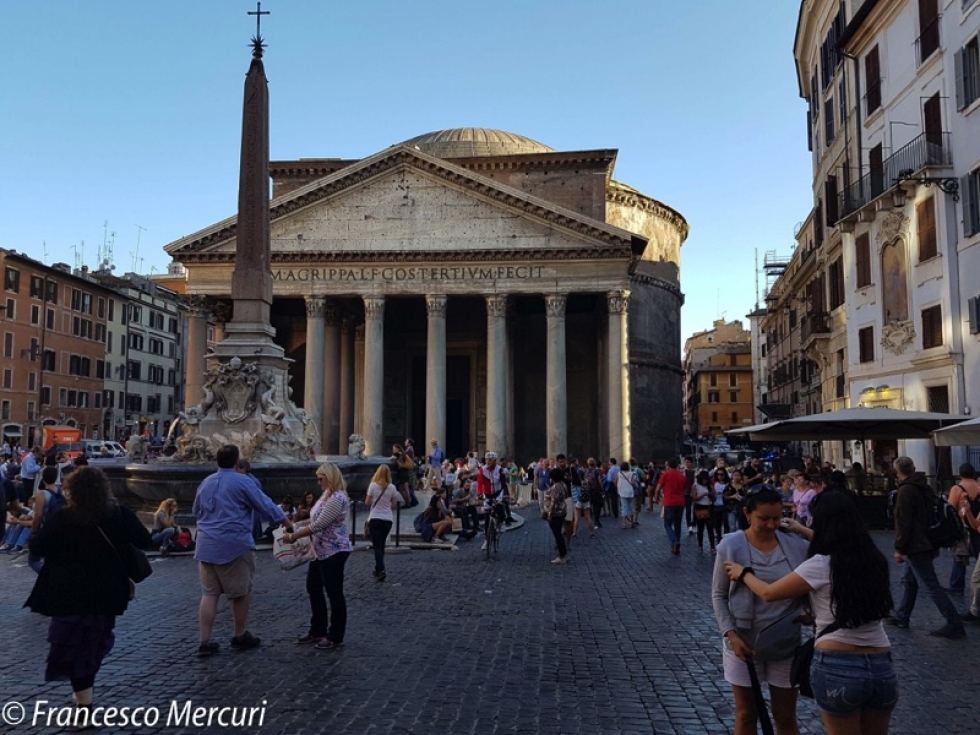Visited every year by millions of people, it strikes for its dimensions, for the perfection of its ratios and for its incredible (and still largely mysterious) construction process. Still today, after more than 2000 years, we don’t know how Romans managed to build a monument able to support a dome of such dimension. Built, as stated before, at the beginning of the imperial age, it was partially restored during Hadrian’s empire (first half of 2nd century CE) since it was damaged by a fire. After the fall of the Western Roman Empire, the emperor of Byzantium donated it to Pope Boniface IV, that turned it into a church dedicated to Mary and Christian martyrs in 609 CE. Stylistically speaking, it is very elaborated. It is made of a large round cella, with an immense dome on top of it, a pronaos (typical of Greco-Roman architecture) preceding the cella, and an avant-corps (simple structure connecting the pronaos and the cella). The pronaos is nothing but a portico with an elegant pediment on top of it. It has 16 columns (8 in grey granite and 8 in red granite) divided in 3 rows more than 12 meters tall. The pronaos was accessible through a longer staircase, now shortened by the street level that rose through the centuries. For this reason, the viewing point has changed too, and so has the perception of the monument. The pediment presents an inscription with the name of who commissioned it and the date it was inaugurated. Right over the inscription there were golden bronze decorations that went lost. The roof of the portico, now empty, once hosted a 450.000 Roman libras bronze structure, later disassembled in order to melt it and turn it into the cannon balls now in Castel Sant’Angelo and the baldachin of the main altar of Saint Peter’s. Once passed through the avant-corps, there is an enormous bronze door (one of the most ancient functioning doors in the world), and next to it, on the outside of the temple, there are two large niches that allegedly hosted statues of Marcus Agrippa and Octavian Augustus. Who was the temple dedicated to? The name, that comes from ancient Greek, means “all the gods”. Therefore, it was built to honor all the gods, in particular Jupiter, Venus and Mars, whose statues were placed inside the temple. The cella of the Pantheon has a circular shape and a diameter of 43,30 meters. The dome is supported by the drum, composed by the podium (lower part) and the attic (upper part), divided by an elegant cornice. The dome, with its diameter, is the second to largest dome in the world and the largest dome in stone. It is also the heaviest in the world with an estimated weight of 17.000 tons! It’s a masterpiece still studied. Roman engineers succeeded in supporting this immense weight through the use of over-6-meters-wide walls, built in bricks and concrete. Inside the walls (also visible on the outside) there are many arches, built with larger bricks in order to better distribute the weight on the ground. This mechanism allows the 17.000 tons of the dome to still be there after more than 2000 years. The dome is built with materials that change depending on the height; the ones closer to the top are lighter. Moreover, its splendid coffering on the ceiling is not there just for aesthetic reasons, but also for structural ones; they make the ceiling lighter, too. On top of the dome there is a 9 meters wide and 1,5 meters thick hole, the only opening that allows light to come inside. Indeed, there are no windows. The podium of the dome’s drum is composed by an apse in front of the door and 6 chapels (3 for each side). Between the chapels there are 8 aediculas, and, in one of these, there are the remains of one of the most important artists of all times: Raphael Sanzio. In 2 chapels there are the sepulchres of Vittorio Emanuele II and Umberto I, the first two kings of Italy, reigning respectively from 1861 to 1878 and from 1878 to 1900. The valuable materials and the splendid marbles of the podium are almost completely original, although there have been some changes through the centuries. On the contrary, the attic lost all its original decorative materials. The floor, except for very few restorations, is the one of the period of the emperor Hadrian, and it is slightly convex. Why so? For sound reasons. From the center of the Pantheon it is possible to hear any sound produced in the temple. Moreover, in that very same position, there are 43,30 meters of distance from the top of the dome. This means that a perfect sphere could be inscribed in the Pantheon. It’s really a unique monument. Still today we don’t know how it was possible to build it. In modern times (we’re talking about last century), there has been an attempt to build a complete reproduction of the monument, that failed. Was Michelangelo right when he said the Pantheon was built according to “an angelic design and not a human one”?
Giuseppe Rosselli






















